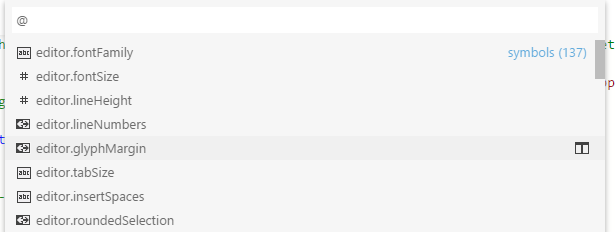JSON
JSON is a data format that is common in configuration files like package.json or project.json. We also use it extensively in VS Code for our configuration files. When opening a file that ends with .json, VS Code provides the following set of features that make it simpler to write or modify the file's content.
JSON Comments
Comments in JSON are an extension to JSON specification that is supported by VS Code. You can use single line (//) as well as block comments (/ /) as used in JavaScript.
IntelliSense & Validation
For properties and values (kb(editor.action.triggerSuggest)), both for JSON data with and without schema we offer up suggestions as you type with IntelliSense. We also perform structural and value verification based on an associated JSON schema giving you red squigglies.

Package and Project Dependencies
We also offer IntelliSense for specific value sets such as package and project dependencies in package.json, project.json, bower.json, ...
Quick Navigation
JSON files can get pretty large and we support quick navigation to properties kb(workbench.action.gotoSymbol) (sometimes refered to as goto symbol) with the Command Palette.

Hovers & Toggle Value
When you hover over properties and values for JSON data with or without schema we will provide additional context.

We also support toggling for allowed values by pressing kb(editor.action.inPlaceReplace.down) or kb(editor.action.inPlaceReplace.up) on a value. In the image above this would switch between true and false.
Formatting
You can format your JSON document (or just a part of it) using kb(editor.action.format) or Format from the context menu.
JSON Schemas & Settings
To understand the structure of JSON files, we use JSON schemas. JSON schemas describe the shape of the JSON file, as well as value sets, default values and descriptions.
The JSON language mode has a set of schema associations preconfigured. Users can extend or overwrite that list in the User or Workspace Settings (File | Preferences | User Settings or Workspace Settings) under the property json.schemas.
Tip: For an overview see User and Workspace Settings.
JSON schemas are identified by an http or https location URL, servers like http://schemastore.org provide schemas for most of the common JSON based configuration files.
Tip: Schemas can also be defined in a file in the VS Code workspace, as well as the VS Code settings files.
The following excerpt from the User Settings shows how bower.json files are mapped to the bower JSON schema located on http://json.schemastore.org/bower.
"json.schemas": [
{
"fileMatch": [
"/bower.json",
"/.bower.json"
],
"url": "http://json.schemastore.org/bower"
},
Mapping a Schema in the Workspace
To map a schema that is located in the workspace, use a relative path. In this example a file in the workspace root called myschema.json will be used as schema for all files ending with .foo.json.
"json.schemas": [
{
"fileMatch": [
"/*.foo.json"
],
"url": "./myschema.json"
},
Mapping a Schema in the Settings Files
To map a schema that is defined in the User or Workspace Settings, use the schema property. In this example a schema is defined that will be used for all files named .myconfig. Note that a URL is always required as an identifier (the URL doesn't need to be resolvable).
"json.schemas": [
{
"fileMatch": [
"/.myconfig"
],
"url": "http://myserver/myschema",
"schema": {
"type": "object",
"properties": {
"name" : {
"type": "string",
"description": "The name of the entry"
}
}
}
},
Next Steps
Read on to find out about:
- Customization - Customize VS Code to work the way you want